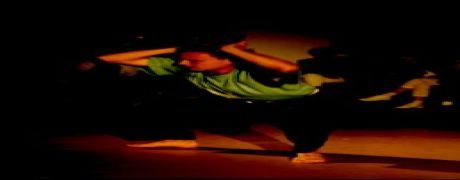About Contact Improvisation
Definitions
There are many ways of defining the dance form Contact Improvisation. Here are two:

Head-to-head, [Left to right] Cathie Caraker and David Beadle.
photo © Bill Arnold.
Contact Improvisation is an evolving system of movement initiated in 1972 by American choreographer Steve Paxton. The improvised dance form is based on the communication between two moving bodies that are in physical contact and their combined relationship to the physical laws that govern their motion—gravity, momentum, inertia. The body, in order to open to these sensations, learns to release excess muscular tension and abandon a certain quality of willfulness to experience the natural flow of movement. Practice includes rolling, falling, being upside down, following a physical point of contact, supporting and giving weight to a partner.
Contact improvisations are spontaneous physical dialogues that range from stillness to highly energetic exchanges. Alertness is developed in order to work in an energetic state of physical disorientation, trusting in ones basic survival instincts. It is a free play with balance, self-correcting the wrong moves and reinforcing the right ones, bringing forth a physical/emotional truth about a shared moment of movement that leaves the participants informed, centered, and enlivened.
Contact Improvisation is an open-ended exploration of the kinaesthetic possibilities of bodies moving through contact. Sometimes wild and athletic, sometimes quiet and meditative, it is a form open to all bodies and enquiring minds.
Contact Improvisation (CI) is a framework for an improvised duet dance. Since it is essentially a dance of investigation of weight, touch, and communication, it adheres to no single definition or pedagogical certification program. All practitioners ultimately participate in the defining, disseminating, and development of the form through their own practice and discovery.
